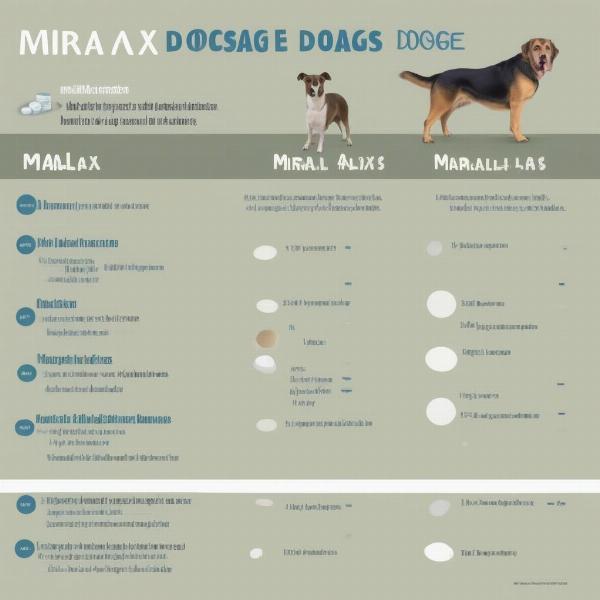Miralax is a common over-the-counter osmotic laxative often used to treat constipation in humans. But what about its use in dogs? Understanding the appropriate miralax dog dose is crucial for pet owners dealing with a constipated canine companion. This article will provide you with a comprehensive guide to using Miralax safely and effectively for your dog, including dosage guidelines, potential side effects, and when to consult a veterinarian.
Understanding Canine Constipation and the Role of Miralax
Constipation in dogs can be caused by various factors, including diet, dehydration, lack of exercise, certain medications, and underlying health conditions. Miralax (generic name polyethylene glycol 3350) works by drawing water into the colon, softening the stool and making it easier to pass. It’s generally considered safe for dogs when administered correctly. However, it’s important to remember that Miralax should not be used as a long-term solution without addressing the underlying cause of the constipation.
Determining the Correct Miralax Dog Dose
The typical miralax dog dose is generally 0.5 to 1 gram per 10 pounds of body weight, mixed with food once or twice daily. However, it’s always best to consult your veterinarian for the most accurate dosage recommendation for your individual dog, as factors like age, breed, and overall health can influence the appropriate dose. Don’t guess the dose of miralax for dogs – always seek professional advice.
Miralax Dosage for Small Dogs vs. Large Dogs
While the general guideline is based on weight, there might be slight variations depending on the dog’s size. For smaller dogs, your vet might recommend starting with a lower dose and gradually increasing it if necessary. For larger dogs, the upper end of the recommended range might be more appropriate.
 Miralax Dosage for Small and Large Dogs
Miralax Dosage for Small and Large Dogs
Administering Miralax to Your Dog
Miralax is a tasteless powder that can be easily mixed with your dog’s food. Ensure that your dog consumes the entire dose by mixing it thoroughly with a small amount of wet food or a highly palatable treat. If your dog is reluctant to eat the food with Miralax, you can try dissolving the powder in a small amount of water and administering it orally using a syringe.
How Long Does It Take for Miralax to Work in Dogs?
Miralax typically takes 24 to 72 hours to produce a bowel movement in dogs. If your dog hasn’t passed stool within this timeframe, contact your veterinarian immediately.
Potential Side Effects and Precautions
While Miralax is generally safe, some dogs may experience mild side effects such as gas, bloating, or diarrhea. If these symptoms persist or worsen, discontinue use and consult your veterinarian.
“It’s crucial to monitor your dog for any unusual symptoms after administering Miralax,” advises Dr. Emily Carter, DVM, a veterinary specialist in internal medicine. “While side effects are rare, it’s always better to be safe than sorry.”
When to Consult a Veterinarian
If your dog’s constipation is severe, chronic, or accompanied by other symptoms such as vomiting, lethargy, or loss of appetite, consult a veterinarian immediately. These could be signs of a more serious underlying condition.
“Never self-treat chronic constipation,” warns Dr. Sarah Miller, DVM, a board-certified veterinary surgeon. “A proper diagnosis from a veterinarian is essential to rule out any underlying medical issues.”
Conclusion
Miralax can be a helpful tool for managing occasional constipation in dogs, but it’s essential to use it responsibly. Always consult your veterinarian for the correct miralax dog dose and monitor your dog for any adverse reactions. Addressing the root cause of constipation is key to ensuring your dog’s long-term digestive health.
FAQ
- How often can I give my dog Miralax? Only use Miralax as directed by your veterinarian. Long-term use should be avoided unless specifically recommended by your vet.
- Can I use human Miralax for my dog? Yes, human Miralax is the same as what is used for dogs, but the dosage is different.
- What should I do if my dog vomits after taking Miralax? Contact your veterinarian immediately.
- Can puppies take Miralax? Consult your veterinarian before giving Miralax to a puppy.
- Is Miralax safe for pregnant or lactating dogs? Consult your veterinarian before giving Miralax to a pregnant or lactating dog.
- What are some natural remedies for dog constipation? Increasing fiber intake through pumpkin puree or adding more water to their diet can sometimes help. However, consult your vet before trying any home remedies.
- Can Miralax interact with other medications my dog is taking? Inform your veterinarian about all other medications your dog is currently on to avoid potential drug interactions.
Related Articles on ILM Dog
About ILM Dog
ILM Dog is your trusted resource for expert advice on dog breeds, health, training, nutrition, grooming, and much more. We provide practical tips and valuable insights to help you navigate every aspect of dog ownership, from choosing the right breed to providing the best possible care for your furry friend. Whether you’re a seasoned dog owner or just starting your journey, ILM Dog offers comprehensive information and guidance to help you build a strong, loving bond with your canine companion. Contact us for personalized support: Email: [email protected], Phone: +44 20-3965-8624.